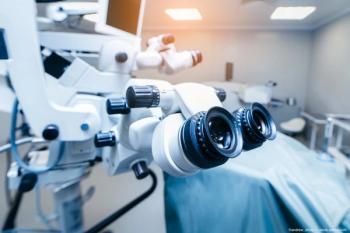
Educational program aims to make glaucoma efficacy 'real'
Two of the most critical and foundational elements in the diagnosis of glaucoma—consistent examination of the optic nerve and aggressively lowering IOP—are one step closer to reality.
Two of the most critical and foundational elements in the diagnosis of glaucoma-consistent examination of the optic nerve and aggressively lowering IOP-are one step closer to reality.
The program will feature a variety of presenters, including the four developers, and an ask-the-experts forum. It will be presented in about 12 cities and at major meetings beginning in 2005. Eventually, the program may be extended to optometrists and primary-care physicians.
"If we wait until there's visual field loss, there's a lot of water over the dam already," Dr. Cantor said. He is the Jay C. and Lucile K. Kahn Professor of Glaucoma Research and Education and director of glaucoma service at Indiana University School of Medicine, Indianapolis.
"Probably 30% to 50% of the optic nerve will be gone before anything shows up," Dr. Cantor said. "Would we be content to wait until a third or half of the heart or liver is gone before we do something about it?"
"You have to do it aggressively-you can't just lower it 20%, you have to go 30% to 40%, and that will bring some cost with it, more visits, and more medication," said Dr. Noecker, who is vice chairman, director of glaucoma service, and associate professor of ophthalmology at the University of Pittsburgh School of Medicine, Pittsburgh.
With these concerns in mind, the pair has teamed with Dr. Gross, professor of ophthalmology, Clifton R. McMichael Chair in Ophthalmology, Cullen Eye Institute, Baylor College of Medicine, Houston, and Dr. Simmons, associate clinical professor, Albany Medical College, and director, Glaucoma Consultants of the Capital Region, Albany, NY.
Frame, review, and zero in The REAL Efficacy educational program is designed around three main points: framing the disease, reviewing the conclusions of recent studies, and zeroing in on the patient's perspective.
Although these points have been presented in a variety of ways over the years, Dr. Noecker said he hopes this program will pull it all together and present a logical way for doctors to decide what to do with all the information.
"They have to believe that glaucoma is a blinding disease that gets worse, that people do go blind, and it has to be treated aggressively; secondly that lowering IOP is a good thing and you have to do it aggressively; and when you have that patient sitting in your chair, you have to communicate whatever is going to make him or her compliant with your therapy," he said.
Ophthalmologists should develop a consistent method for examining the optic nerve, Dr. Cantor said.
Newsletter
Don’t miss out—get Ophthalmology Times updates on the latest clinical advancements and expert interviews, straight to your inbox.


















































.png)


